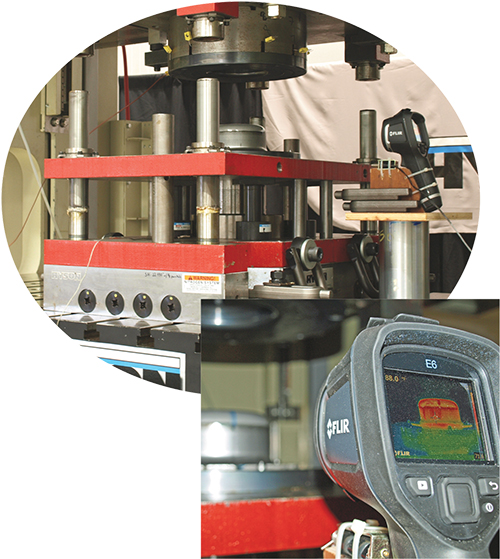iTool in Action
We caught up with Hoschouer and a team from Irmco at Hyson headquarters near Cleveland, OH, earlier this year. Hyson’s 300-ton Komatsu servo press was enlisted to put the iTool through its paces on behalf of Shiloh. Hoschouer used the setup, which included 16 tons of nitrogen blankholder force built into the tool, complemented by a Hyson 50-ton servo-controlled hydraulic cushion, to blind-test 24 different lubricants—synthetics and oil-based products from several suppliers. Over two days of testing, nearly 400 12-in. blanks were deep-drawn; materials tested were 2-mm-thick mild, HSLA and stainless steels, and 1.4-mm DP1180 (a duplex AHSS grade).
Bennett Tool built the ASTM-design iTool, which features eight temperature sensors to monitor die temperature during testing, a load cell in the die, and an FLIR thermal-imaging camera to capture part-temperature data during drawing.
The Irmco iTool Consortium Ten years ago, Dr. Taylan Altan invited lubricant supplier Irmco to participate in his metalforming research at The Ohio State University’s Center for Precision Forming, and then later when he joined the Edison Welding Institute Forming Center. Dr. Altan’s team was conducting cup-draw tests (CDT) on advanced high-strength steels (AHSS). The CDT is a practical friction test, and Irmco had experienced good correlation of its lubricant performance on difficult draws in the real world. Unlike benchtop friction equipment, the CDT utilizes an actual press and die. Irmco envisioned a need for stampers to evaluate lubricants in a controlled, unbiased manner—without using their own, valuable production-press time. It also recognized the industry’s need to better understand the capabilities of servo presses, and to gauge how forming in a servo press impacts tooling and part temperature. After presenting these concepts at Great Designs in Steel, in May 2015, the Irmco iTool Consortium was born. The consortium: GE Louisville’s Advanced Mfg. Development Team, Bennet Tool and Hyson. Shiloh and other metal stampers also have come on board.
“The test setup performed perfectly for deep-drawing of mild, HSLA and stainless steels,” says Hoschouer, “providing a wide spread of data for the various lubricants. The extra tonnage from the servo-hydraulic cushion played a critical role in ensuring we developed sufficient blankholder force.
“However, with the AHSS material, the data is too clumped together to make complete evaluations,” he adds, “so we’ll be conducting further studies on AHSS, as well as on aluminum, using our inhouse 600-ton hydraulic press. It allows us to apply tonnage throughout the entire stroke.”
In addition to tracking tool and part temperature during drawing, the test procedure also called for automated circle-grid analysis of test samples, using the Argus system, to evaluate strain and thinning; and manual measurement of the perimeter of each blank.
“Ideally, we want the blanks to draw into the die, rather than stretch and thin,” Hoschouer says. “With this setup, we can correlate material movement to temperature while capturing strain and workpiece-temperature data. The better the lubricant the less thinning we get.”
Drum Roll, Please
The preliminary results are in, and Hoschouer and his team have successfully narrowed the list of candidate lubricants down to five. In early summer, Hoschouer expects to enroll those five lubricants in a full-scale testing program at one of Shiloh’s stamping plants, on production parts (parts will be washed prior to shipping to the customer).
“We’ll test the five lubricants on an array of materials and parts,” Hoschouer says, “and get a better idea of which of the five lubricants actually makes a positive impact on our processes. We hope to narrow the list of finalists down to two or three lubricants that we eventually will move into widespread production.
“In fact,” Hoschouer continues, “some of the finalists actually performed very well on all of the materials we’ve tested—maybe not the best on all materials, but in the top five on all materials. If that holds up in full-scale testing, we might be able to get down to one or two lubricants.” MF
View Glossary of Metalforming Terms
See also: IRMCO
Technologies: Lubrication












 Video
Video